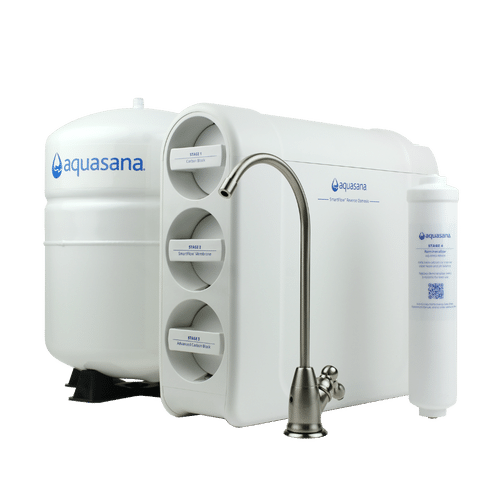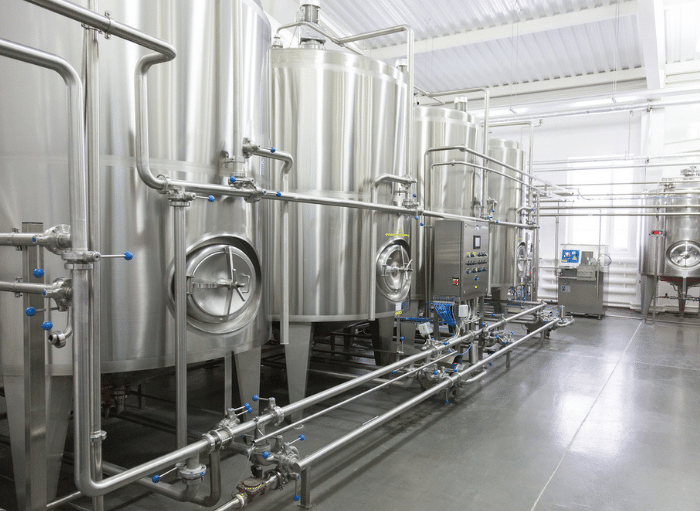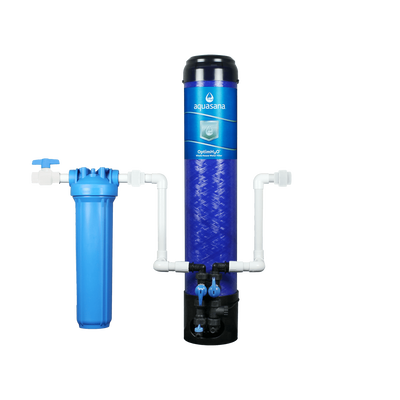Nanofiltration, like ultrafiltration, has specialty applications including:
- Softening hard water
- Removing metals from wastewater
- Scrubbing pesticides from groundwater
What is reverse osmosis?
Reverse osmosis has the smallest pore size of the three methods, at 0.0001um. Reverse osmosis will remove all organic compounds, all viruses, and most minerals, including calcium, magnesium, salt, and lead. What remains is nearly pure, clear water.
Reverse osmosis is a preferred method for purifying drinking water. According to the Safe Drinking Water Foundation, reverse osmosis systems played key roles in ending two multi-year boil orders in Canadian communities. The process is also commonly used in the bottling of spring water. Other applications include water desalination, equipment cleaning, and food and beverage processing.
Difference Between Microfiltration, Ultrafiltration, Nanofiltration, and Reverse Osmosis
The practical difference between ultrafiltration, nanofiltration, and reverse osmosis is the amount of material that's removed from the water. Imagine pouring water through a colander vs. cheese cloth. The colander will filter out large substances, while the cheese cloth will filter out the big stuff plus some smaller materials, too.
If ultrafiltration and nanofiltration are the colander, then reverse osmosis is more like cheesecloth. The tiny pores in a reverse osmosis membrane effectively filter out nearly all particles.
A more scientific explanation of the differences across these methods is shown in the table below.
.jpg?sw=1920&sfrm=png)
Which of these options is best?
For water you use in your home, reverse osmosis is the best filtration method. Reverse osmosis filters out up to 99% of contaminants. Microfiltration, ultrafiltration, and nanofiltration cannot reach the same level of purity.
Reverse osmosis has a drawback, though. The process filters out some good minerals along with the bad stuff. Specifically, reverse osmosis strips out calcium, magnesium, and potassium from water. Those three minerals have known health benefits and contribute to the taste of drinking water.
You can combat this drawback by investing in a filter that remineralizes the water. Aquasana's under-sink SmartFlow® Reverse Osmosis does this as part of its four-step purification process:
- Water is processed through a carbon filter to remove pesticides and other organic chemicals.
- Water is pushed through a reverse osmosis membrane to filter out fluoride, nitrates, nitrites, lead, radium, and arsenic.
- The system's Claryum® filter removes heavy metals.
- A remineralizer adds back calcium, magnesium, and potassium for taste and health benefits.
UNDER SINK WATER FILTER
SmartFlow® Reverse Osmosis
Combines Claryum® and reverse osmosis technology to remove 88 contaminants including fluoride and arsenic.

Thanks to the multistep filtering, the OptimH2O® Reverse Osmosis + Claryum removes up to 99% of 88 known contaminants. The system is tested and certified to NSF/ANSI Standards 42, 53, 58, and 401 for the claims specified on the Performance Data Sheet in the Owner's Manual.
In summary, reverse osmosis is the highest standard of purification for drinking water. Combine reverse osmosis with remineralization and you'll have pure water that tastes great and is healthful, too.



